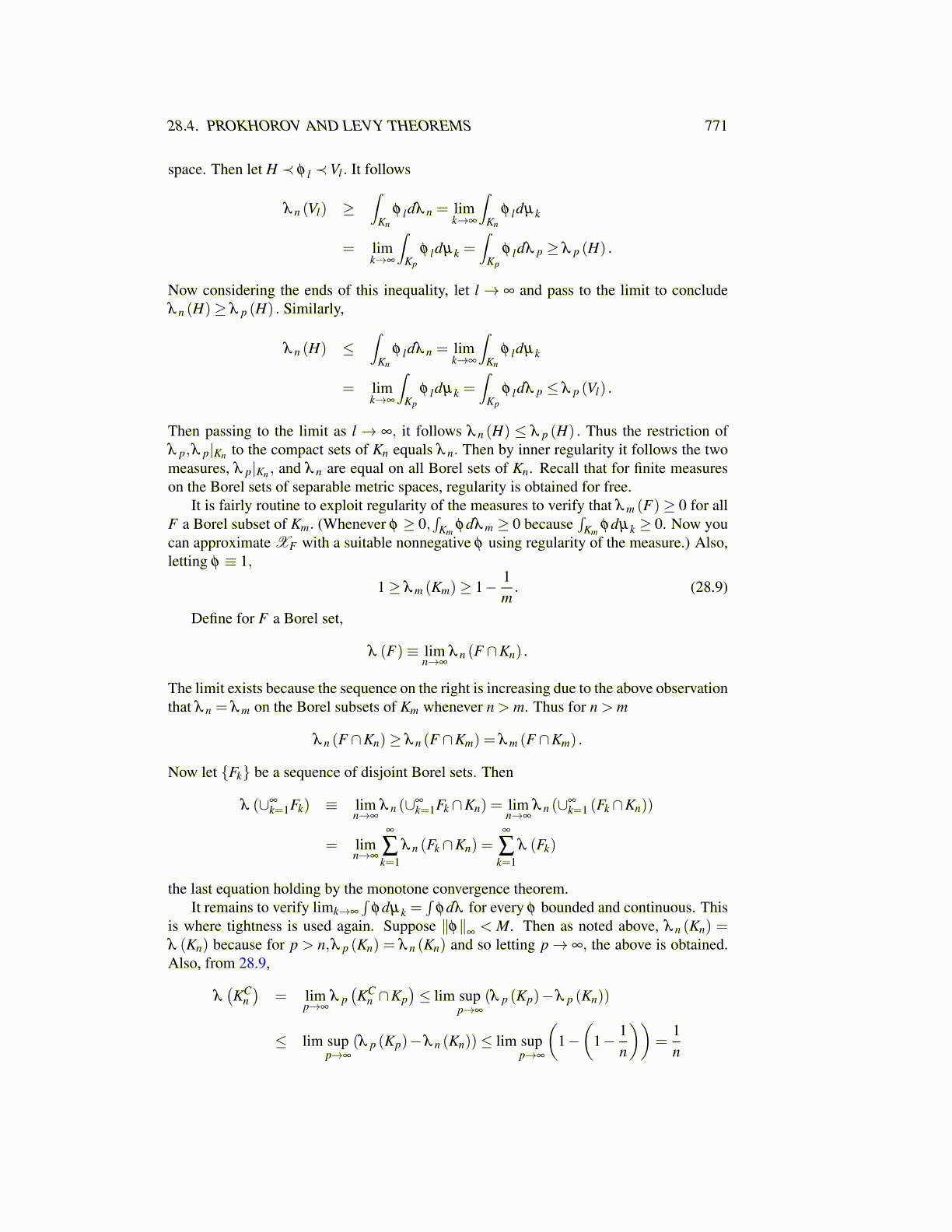
28.4. PROKHOROV AND LEVY THEOREMS 771
space. Then let H ≺ φ l ≺Vl . It follows
λ n (Vl) ≥∫
Kn
φ ldλ n = limk→∞
∫Kn
φ ldµk
= limk→∞
∫Kp
φ ldµk =∫
Kp
φ ldλ p ≥ λ p (H) .
Now considering the ends of this inequality, let l → ∞ and pass to the limit to concludeλ n (H)≥ λ p (H) . Similarly,
λ n (H) ≤∫
Kn
φ ldλ n = limk→∞
∫Kn
φ ldµk
= limk→∞
∫Kp
φ ldµk =∫
Kp
φ ldλ p ≤ λ p (Vl) .
Then passing to the limit as l → ∞, it follows λ n (H) ≤ λ p (H) . Thus the restriction ofλ p,λ p|Kn to the compact sets of Kn equals λ n. Then by inner regularity it follows the twomeasures, λ p|Kn , and λ n are equal on all Borel sets of Kn. Recall that for finite measureson the Borel sets of separable metric spaces, regularity is obtained for free.
It is fairly routine to exploit regularity of the measures to verify that λ m (F)≥ 0 for allF a Borel subset of Km. (Whenever φ ≥ 0,
∫Km
φdλ m ≥ 0 because∫
Kmφdµk ≥ 0. Now you
can approximate XF with a suitable nonnegative φ using regularity of the measure.) Also,letting φ ≡ 1,
1≥ λ m (Km)≥ 1− 1m. (28.9)
Define for F a Borel set,
λ (F)≡ limn→∞
λ n (F ∩Kn) .
The limit exists because the sequence on the right is increasing due to the above observationthat λ n = λ m on the Borel subsets of Km whenever n > m. Thus for n > m
λ n (F ∩Kn)≥ λ n (F ∩Km) = λ m (F ∩Km) .
Now let {Fk} be a sequence of disjoint Borel sets. Then
λ (∪∞k=1Fk) ≡ lim
n→∞λ n (∪∞
k=1Fk ∩Kn) = limn→∞
λ n (∪∞k=1 (Fk ∩Kn))
= limn→∞
∞
∑k=1
λ n (Fk ∩Kn) =∞
∑k=1
λ (Fk)
the last equation holding by the monotone convergence theorem.It remains to verify limk→∞
∫φdµk =
∫φdλ for every φ bounded and continuous. This
is where tightness is used again. Suppose ∥φ∥∞< M. Then as noted above, λ n (Kn) =
λ (Kn) because for p > n,λ p (Kn) = λ n (Kn) and so letting p→ ∞, the above is obtained.Also, from 28.9,
λ(KC
n)
= limp→∞
λ p(KC
n ∩Kp)≤ lim sup
p→∞
(λ p (Kp)−λ p (Kn))
≤ lim supp→∞
(λ p (Kp)−λ n (Kn))≤ lim supp→∞
(1−(
1− 1n
))=
1n